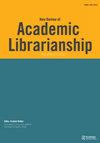Trendspotting - Looking to the Future in a Post-Pandemic Academic Library Environment
IF 2.3
Q2 INFORMATION SCIENCE & LIBRARY SCIENCE
引用次数: 6
Abstract
In March 2020, the Covid-19 global pandemic meant that libraries had to respond and react quickly in order to adapt services as best they could. It is generally accepted that academic libraries, for the most part, were able to do this very effectively due to having already positioned themselves within a fully functioning digital environment (Appleton, 2021; Bullington et al., 2021; Falt & Das, 2020). Not wishing to speak too soon, but at my university campus, it feels as if we are starting to return to some sort of normality with Covid-19 restrictions being gradually lifted in the United Kingdom and indeed in other parts of the world. This has allowed me to start thinking about what this now means for the future of academic libraries. There has been plenty written about the post pandemic higher education environment and the ‘new-normal’ for academic libraries, and how some of the changes forced upon academic libraries during the pandemic (e.g., digital-first policies, online teaching, hybrid information environments, etc.) may actually be beneficial in the longer term, as well as being responses to the global Covid-19 outbreak (Appleton, 2020; Blake, 2020; Carlson, 2021; Cox, 2020). The 2021 special issue of New Review of Academic Librarianship focused on the acceleration of the digital shift in academic libraries, as a significant outcome from some of the changes that academic libraries had to make. Examples from that particular issue include case studies on the impact of the digital shift on library learning and instruction (Avon, Houston, Nunes, & Perkins, 2021), on digital content acquisition (Brine & Knight, 2021) and on student engagement (Matizirofa, Soyizwapi, Siwela, & Khosie, 2021). It is likely that some of the experiences we are having now will shape how academic libraries continue to develop in a post-pandemic world, and it would be interesting to see whether there are common trends emerging across geographic boundaries, as we move into a new era for academic libraries. Certainly, before the pandemic, academic libraries and their professional associations used environmental scanning techniques in order to spot trends across the sector, which in turn helped to inform strategy and development at local, national and international levels. The last set of top ten trends identified by the Association of College and Research Libraries Research Planning and Review Committee was published early in 2020, just before any Covid restrictions and library closures were enforced (ACRL, 2020). The ACRL top ten trends tend to be used as a barometer for many academic libraries with regard to highlighting the big issues of the day which need to be strategically addressed. SCONUL, in the United Kingdom also periodically commissions research into national academic library issues ( for example: Baker & Allden, 2017; Pinfield, Cox, & Rutter, 2017) in order to highlight trends and to aid strategic development. The latest example from SCONUL is a report published in 2021 about trends in the physical usage of academic libraries, and whilst this report has been published as part of their ‘Libraries after Lockdown’ work, the research was largely carried out before the pandemic (Cox & BensonMarshall, 2021).趋势发现-在疫情后的高校图书馆环境中展望未来
2020年3月,新冠肺炎全球大流行意味着图书馆必须迅速做出反应,以尽可能调整服务。人们普遍认为,学术图书馆在很大程度上能够非常有效地做到这一点,是因为它们已经将自己定位在一个功能齐全的数字环境中(Appleton,2021;Bullington等人,2021;Falt和Das,2020)。我不想过早发言,但在我的大学校园里,随着新冠肺炎限制在英国乃至世界其他地区逐渐解除,我们似乎开始恢复某种正常。这让我开始思考这对学术图书馆的未来意味着什么。关于疫情后的高等教育环境和学术图书馆的“新常态”,以及疫情期间迫使学术图书馆做出的一些改变(例如,数字优先政策、在线教学、混合信息环境等)在长期内实际上可能是有益的,已经有很多文章,以及应对全球新冠肺炎疫情(阿普尔顿,2020;布莱克,2020;卡尔森,2021;考克斯,2020)。《学术图书馆学新评论》2021年特刊聚焦于学术图书馆数字化转型的加速,这是学术图书馆必须做出的一些改变的重要成果。该特定问题的例子包括数字转型对图书馆学习和教学影响的案例研究(Avon,Houston,Nunes,&Perkins,2021)、数字内容获取(Brine&Knight,2021)和学生参与度(Matizirofa,Soyizwapi,Siwela,&Khosie,2021)。我们现在的一些经验很可能会影响学术图书馆在疫情后的世界中如何继续发展,随着我们进入学术图书馆的新时代,看看是否存在跨越地理界限的共同趋势会很有趣。当然,在疫情之前,学术图书馆及其专业协会使用环境扫描技术来发现整个行业的趋势,这反过来又有助于为地方、国家和国际层面的战略和发展提供信息。学院和研究图书馆协会研究规划和审查委员会确定的最后一组十大趋势于2020年初发布,就在任何新冠肺炎限制和图书馆关闭实施之前(ACRL,2020)。ACRL十大趋势往往被用作许多学术图书馆的晴雨表,以突出当今需要战略性解决的重大问题。英国SCONUL还定期委托对国家学术图书馆问题进行研究(例如:Baker和Allden,2017;Pinfield、Cox和Rutter,2017),以突出趋势并帮助战略发展。SCONUL的最新例子是2021年发布的一份关于学术图书馆物理使用趋势的报告,虽然该报告是作为其“封锁后的图书馆”工作的一部分发布的,但该研究主要在疫情之前进行(Cox&BensonMarshall,2021)。
本文章由计算机程序翻译,如有差异,请以英文原文为准。
求助全文
约1分钟内获得全文
求助全文
来源期刊

New Review of Academic Librarianship
Social Sciences-Library and Information Sciences
CiteScore
3.40
自引率
0.00%
发文量
20
 求助内容:
求助内容: 应助结果提醒方式:
应助结果提醒方式:


